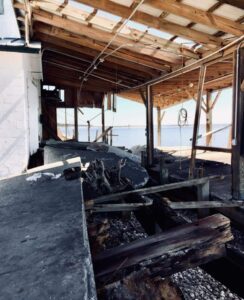The view from this week’s brief video blog is from Chicago’s 606 Trail, but David Taylor, our videographer for Planning to Turn the Tide, and I were actually headed out on a much longer trail for nearly two weeks. In a car containing his video equipment, we departed Chicago on Thursday, July 6, and drove across Illinois, Iowa, and Nebraska to arrive two days later in Broomfield, Colorado, the site of the 2023 annual Natural Hazards Workshop. We returned to Chicago on Tuesday evening, July 18.
Click here to view this new video blog installment in our ongoing series.
Why such a long road trip for this documentary film of the APA Hazard Mitigation and Disaster Recovery Planning Division? We had long hoped that we could combine travel to Colorado and Iowa in a single trip. This project, dependent on grants and individual and corporate donations, does not thrive on an expensive news media budget. It is driven by a great deal of volunteer support from planners and supporters of the planning community across the country, and specifically by ad hoc groups organized in the locations where we have chosen to film segments that we think will be of the greatest educational and inspirational value in the final product. Part of the answer, therefore, lies in a diligent frugality with our donors’ money.
Flying is inevitable to some locations. In this case, however, an extensive network of grassroots contacts let us bring several elements of the production together in a short, concentrated time scale. First, we are extremely grateful to the University of Colorado’s Natural Hazards Center, which welcomed our operation enthusiastically at its conference at the Omni Interlocken Hotel and Resort in Broomfield, which took place July 9-12. Their embrace allowed us to film interviews at the hotel throughout the conference.
At the same time, support from the Colorado Chapter of the American Planning Association, as well as other volunteers, made it possible to arrange meaningful visits to communities along the Front Range that have been affected over the past decade by drought, wildfire, and flooding, and to interview people who could share their knowledge and experience, which will be detailed in upcoming blog posts over the next few weeks. That filled out the first week.
Over the following weekend, we made our way back east again to Iowa, stopping in Iowa City and Cedar Rapids to discuss some meaningful Iowa planning innovations at both the state and local levels, dealing mostly with floods but also larger implications of climate change. I will note here that, while we stayed overnight in Lincoln on this return trip, we experienced what I had already seen in Chicago two weeks earlier: significant air pollution sweeping through Nebraska as a result of drifting smoke from raging wildfires in Canada.
Little more than a week earlier, on our way out to Colorado, we had stopped in Grand Island, Nebraska, to visit on a late Friday afternoon with Chad Nabity, AICP, the planning director for Hall County and Grand Island. Chad is the sort of remarkable professional who loves to give back to his profession. He currently serves the American Planning Association as Chair of the Divisions Council, of which HMDR is a member. In our chat at his office in City Hall, as well as at a nearby chocolate shop, he discussed Grand Island’s encounters with natural disasters, which included some flooding issues but also the Night of the Twisters in 1980, when seven tornadoes visited Grand Island in rapid succession, devastating parts of the community and triggering frantic emergency response efforts. Chad himself was entering high school that year in Grand Island. Although his parents’ house suffered little damage, he says, “not the same for close friends of mine.” Later, Chad went off to college, earned his planning degree, and eventually returned as a Grand Island native in the position he now holds. Not surprisingly, Chad is also a member of HMDR.
The evening became famous enough to draw Hollywood attention, resulting in the first Family Channel movie production, titled, you guessed it, Night of the Twisters. The movie itself drew from a 1984 young adult book of the same name by Ivy Ruckman. I guess we are not the first to think of making a movie about disasters, but I confess to viewing most such movies with a jaundiced eye because of their tendency to sensationalize such events.
We are producing an educational documentary because we are more interested in telling the story of how to prevent or mitigate such hazards, how to create resilient communities, and how to persist in the long road to recovery that inevitably follows. We want to build a community of interest for better planning for disaster resilience.
If you think that is a worthwhile enterprise, I will once again mention our need for financial support. Use the QR code below or this link to help us out. We will truly appreciate it.
Jim Schwab



